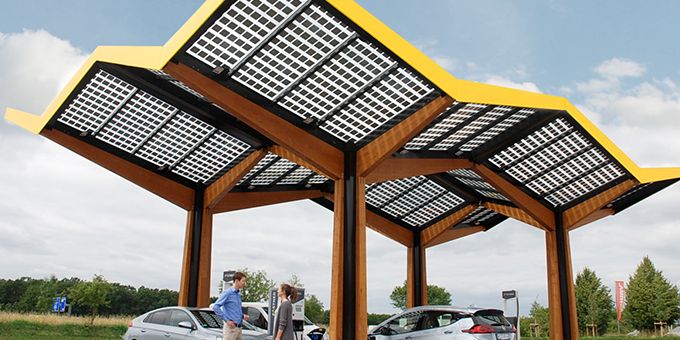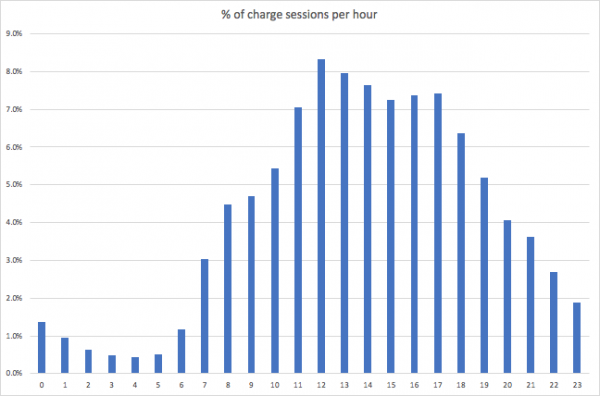Fast charging stations on medium voltage grids have unique properties that can play a role in stabilising the grid & absorb large amounts of renewable energy (solar and wind).
 Why Fast Charging Stations Are Good for the Grid
Why Fast Charging Stations Are Good for the Grid

Contributed by | Fastned
Reprinted with permission from Fastned:
Fastned is exclusively focused on fast (>50 kW) charging. We get a lot of questions about the impact of fast charging on the electricity grid. In this blog we’ll share some insights based on 100.000+ fast charging sessions and 5+ years of operating a vertically integrated fast charging network.
Summary
Fast charging stations on medium voltage grids have unique properties that can play a role in stabilising the grid & absorb large amounts of renewable energy (solar and wind).
Part 1: Value of fast charging to the electricity grid
- All future Fastned charging stations are connected to robust medium voltage distribution grids. This helps to divert load from the vulnerable low voltage grid.
- Large fast charging stations with 10+ chargers are able to serve hundreds of cars per day, yet require just one grid connection. This dramatically lowers the burden of connecting to grid companies.
- Fast charging stations connected to the medium voltage grid are very suitable to be equipped with additional battery storage. On site batteries can (a) increase the maximum capacity of the station during peak moments (b) in aggregate, these batteries can act as a large scale flexible resource for the grid operator.
Part 2: Value of fast charging to renewable energy integration
- Our data shows that aggregate demand at our fast charging stations follows a predictable and stable load curve during the day.
- Fast charging happens mainly during daytime, when the sun is shining and more and more renewable energy will be produced. Increasing supply of solar energy can thus be directly absorbed by fast charging.
- Fast charging is complementary to slow charging (which mostly happens overnight). Fast charging can thus help to spread the total demand for charging over 24 hours.
- In the future, with more self driving EVs on the road, the value to the grid & renewable energy adoption can be increased further. Fully autonomous EVs can respond dynamically to price signals of fast charging stations to optimise for fast charging on moments of high renewable energy output.
Part I: the grid
If we want to avoid altering the climate of our planet beyond recognition, we should at least do these two things as fast as possible:
- Electrify transport, heating, industry and other economic activities
- Deploy renewable energy such as solar and wind at gigantic scale to clean up electricity generation
The energy transition will thus lead to the electrification of many things that presently rely on the combustion of fossil fuels: industry, heating and mobility. Electricity generation and demand is set to soar in the coming decades, straining the electricity grids of industrialised countries.
Fastned has been thinking for years about how fast charging can be the most beneficial to the electric grid in such a clean energy future. We have come to believe that strategic deployment of fast charging stations can help minimise the impact of electric mobility on the grid.
Minimise the impact on the low voltage grids
Getting electricity to your home usually involves three ‘voltage steps’ of the grid:
Power plant → High voltage → Medium Voltage → Low Voltage → Homes & businesses
The low voltage grid is the last step of the network that provides homes and businesses with electricity. It is also by far the most vulnerable as it is usually laid out for very modest usage. On top of that people will install electric heat pumps, put solar panels on their roofs and start to cook with electricity. All this extra activity will strain the low voltage grid in particular.
Fastned therefore connects its fast charging stations directly to the medium voltage grid - thus bypassing the low voltage grid. The power draw of a large fast charging station is simply too much for the low voltage grid. The medium voltage grid is designed to handle fast charging loads much better. It is a myth that fast charging is inherently bad for the grid; it’s just not suited for low voltage grids.
With fast charging stations, we need far fewer additional grid connections
A single medium voltage grid connection can be used very efficiently to deliver electricity to large numbers of EVs. Let’s conservatively assume that over time the real average fast charging speed will reach 125 kW (this is not a speculative speed, as this is the current maximum charging speed of Tesla vehicles). Let’s also assume that a fast charger is only active 8 hours per day on average. That is 1000 kWh (8 hours * 125 kW) per fast charger per day. It gets better. Fast chargers can be bundled together on a station. So a single station with 10 individual fast chargers can deliver 10.000 kWh per day. As a comparison: the average slow charger (with dual outlets) in the Netherlands delivered 8,5 kWh per day in 2016. Obviously this number will increase once more cars are fully electric, but 3 orders of magnitude (10 kWh versus 10.000 kWh) is quite a difference.
However, the fast charging station needs only one MW grid connection, one permit and a fraction of the surface area compared to public slow charging. In order to provide the same charging capacity 1000 slow chargers and 1000 individual LV grid connections are needed. Every grid connection requires a permit, road works and bureaucracy. And keep in mind that grid companies already have great difficulty finding suitable personnel (at least in The Netherlands). Realising a lot of small grid connections for public slow chargers could prove to be a bottleneck for charging infrastructure once car makers start mass production and EVs hit the road in large numbers.
Easy integration of battery storage on fast charging stations to maximise potential of grid connections
Batteries are a perfect match for fast charging stations because they can increase the capacity of a fast charging station beyond the capacity of the grid connection and in addition deliver services to the grid. Gradually adding batteries to fast charging stations will further stabilise the grid and enable stations to increase their capacity at peak moments.
More charging capacity with the same grid connection
There may be good reasons to be able to control the maximum demand on a grid connection, or to refrain from upgrading a grid connection. Examples are: kW max capacity rates, limits of the local medium voltage grid, distance from the medium voltage grid, exceptionally high costs for larger (i.e. 2MW+) grid connections.
With growing demand for fast charging from EVs limited capacity or high kW max capacity rates could become a bottleneck to the growth of fast charging. At peak hours (when all chargers are occupied) the load per station will be very costly or exceed the grid connection of that station. Although upgrading the capacity of the grid connection would solve this problem, it could be more economical to add a battery and use that to increase capacity at peak moments. Instead of curtailing the maximum charge rate per fast charger per station, on site batteries can temporarily provide power to meet high demand.
Flexibility services
Apart from controlling the demand on a grid connection, batteries at fast charging stations could deliver other services to the grid. For example, a fast charging station with batteries installed can behave more intelligently and shift demand away from the grid when it is incentivised to do so. An example would be to switch to battery power (and thus lower demand) in the early evening when peak demand generally occurs. Co-locating batteries on large fast charging station is economical, because medium voltage grid connections are already in place. Taken together, a network of 1000 fast charging stations with 1MW battery each will have 1GW of distributed, largely flexible power.
Part II: renewable electricity
In the coming years, the source of electricity in many countries around the world will change from centrally generated and mostly fossil powered to distributed, variable and mostly renewable. What does this mean for charging electric cars?
Fast charging → predictable aggregate demand
The combined charging sessions of Fastned (and other providers) provide a predictable and stable load throughout the day. Contrary to the popular belief that fast charging is a ‘spikey’ and large power draw on the grid, a single rapid charging session has limited impact on the MV grid. With more electric vehicles on the road, fast charging stations will have a steady stream of customers. At this point, charging sessions are best to be looked at in an aggregated form. Based on our data from > 100.000 fast charging sessions (figure 1), we found that this demand begins in the morning when people start driving around, and stops when people go home in the evening. The same pattern repeats day after day.
Fast charging happens mainly when the sun shines (and electricity is cheap)
With millions of electric cars on the road, the electricity demand resulting from daytime fast charging will result in predictable electricity demand which can be partly matched by solar power generation (figure 1). In fact, in electricity markets around the world spot electricity prices are already dipping during daytime because solar floods the electricity grids when the sun shines.

Figure 1: Distribution of fast charging sessions throughout the day (24 hours). There’s a great opportunity to match this demand with solar energy generation.
Daytime fast charging complements nighttime slow charging
While fast charging takes place mainly during the day, slow charging is often done overnight (when people come home and plug in their EV). The combination of slow and fast charging is thus very helpful in spreading EV charging more evenly over 24 hours.
Shared and autonomous EVs
Autonomous EVs will probably play an important role in the future of transportation. Fleets of shared, autonomous EVs have a strong economic incentive to spend the least possible time recharging, because they make money while driving people around. It doesn’t make sense to have them parked and charging on the curbside for hours. We believe these shared and autonomous EVs can be incentivised to fast charge when there’s a lot of renewable energy available. More than human drivers (who have better things to do) autonomous EVs can respond to incentives to fast charge when the costs are low.
Conclusion
As long as fast charging stations are (1) connected to the medium voltage grid and (2) prepared for future onsite battery storage, they can be a simple and grid-friendly solution to charge large amounts of EVs on renewable energy. Because large fast charging stations require limited land area and very few grid connections, they are very suitable to charge large numbers of EVs once electric driving become more commonplace.
The content & opinions in this article are the author’s and do not necessarily represent the views of AltEnergyMag
Comments (0)
This post does not have any comments. Be the first to leave a comment below.
Featured Product

